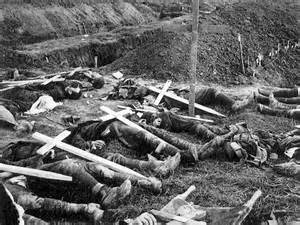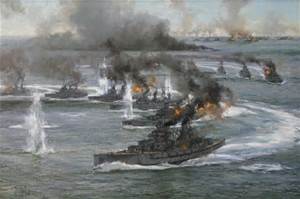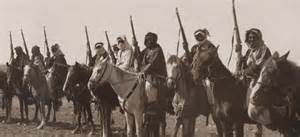Looking back with the lucidity of hindsight, we can see that the year of 1916 was a decisive turning point swaying the eventual outcome of World War I. The war  that most of Europe thought would be over by Christmas 1914 had turned into a bloody stalemate fought mostly in the trenches of far flung battlefronts. The increasing tempo of the war during abysmal 1916 would provide the base for many of the ruinous events still to come.
that most of Europe thought would be over by Christmas 1914 had turned into a bloody stalemate fought mostly in the trenches of far flung battlefronts. The increasing tempo of the war during abysmal 1916 would provide the base for many of the ruinous events still to come.
Faced with an unanticipated military stalemate, anxious and frustrated general staffs tried out and implemented new techniques such as the creeping artillery barrage. A new tool of war, the tank, was introduced in September 1916. In the air, the airplane was proving to have an expanding range of military applications. By 1916, the soldiers on both sides had lost faith in the talk of imminent victory. They became resigned to war as a permanent state in their lives which were growing ever shorter in deadly environment of the front. As the cynicism of the soldiery increased a gap developed, separating the grim mentality of the soldiers from that of the civilians and politicians back home.
Among the leaders of the warring nations, a discouraging reality took hold. Despite the intense action on other fronts, they realized that the war would be  won or lost on the Western Front. The feeling was widespread on both sides that a negotiated peace was no longer possible, it was beyond the reach of politicians. Despite the horrendous losses, the only way to end the war was to fight to the finish. As the leadership’s attitude hardened, a contrary trend was taking hold among the populations. Public sentiment was shifting, despair and anger increased as the casualties mounted. The murmuring against stupid leaders, flawed tactics, callous military leadership and the increasing hardships faced by the home front began to rise.
won or lost on the Western Front. The feeling was widespread on both sides that a negotiated peace was no longer possible, it was beyond the reach of politicians. Despite the horrendous losses, the only way to end the war was to fight to the finish. As the leadership’s attitude hardened, a contrary trend was taking hold among the populations. Public sentiment was shifting, despair and anger increased as the casualties mounted. The murmuring against stupid leaders, flawed tactics, callous military leadership and the increasing hardships faced by the home front began to rise.
During 1915, the combatants suffered 1.8 million casualties on the Western Front. In 1916, as a result of the enormous battles of Verdun and the Somme, Britain, France and Germany sustained 2.2 million casualties in eight months. In one day during the battle of the Somme, Britain suffered 57,000 casualties, a new record. The Somme struggle relieved some the pressure on the French at Verdun, stretching German resources thinner in a conflict that had degenerated into a contest of attrition.
Britain, France and Germany sustained 2.2 million casualties in eight months. In one day during the battle of the Somme, Britain suffered 57,000 casualties, a new record. The Somme struggle relieved some the pressure on the French at Verdun, stretching German resources thinner in a conflict that had degenerated into a contest of attrition.
Although the British lost more ships at the naval battle of Jutland, the German High Seas Fleet did not achieve a break out. It remained bottled up in port. With the German fleet immobilized, the success of the British naval blockade was assured. Over time, it would cause the deterioration of Germany’s home front, increasing unrest, malnutrition, sickness and near starvation as the war dragged on. After the naval setback at Jutland, German submarines would go back to commerce raiding in an attempt to strangle British supply lines. It was a move that would help ensure America’s entry into the war.
assured. Over time, it would cause the deterioration of Germany’s home front, increasing unrest, malnutrition, sickness and near starvation as the war dragged on. After the naval setback at Jutland, German submarines would go back to commerce raiding in an attempt to strangle British supply lines. It was a move that would help ensure America’s entry into the war.
The costly battles fought in the east were having a destructive impact on the brittle governments of Austria-Hungary, Russia and the Ottoman Empire. As imperial idealism foundered, support for the war among the peoples of split loyalty serving in the ranks of Austria-Hungary’s multi-ethic forces began to dissolve. Supply issues and their related hardships plagued the Russian and Ottoman forces. In Eastern Europe, the movement toward revolution and the drive to national self-determination began to grow. Although put down by British forces, the Easter Rising in Ireland gave a big boost to the movement that would lead to the establishment of the Irish Free State six years later.
In the volatile Middle East, the British and French had stirred up an Arab revolt to undermine the Ottoman Empire and to prevent Germany from promoting an  Arab movement against them. In May 1916, the two colonial powers concluded the ill-famed Sykes-Picot Agreement. It divided the Arab Ottoman provinces into future areas of British and French control and influence. Some of the malevolent results of the British and French map redrawing exercise linger to this day, reflected in the ongoing turmoil in Syria and Iraq.
Arab movement against them. In May 1916, the two colonial powers concluded the ill-famed Sykes-Picot Agreement. It divided the Arab Ottoman provinces into future areas of British and French control and influence. Some of the malevolent results of the British and French map redrawing exercise linger to this day, reflected in the ongoing turmoil in Syria and Iraq.
By and large, 1916 was an extraordinary year of war. The horrors that came with large scale industrialized warfare was altering the societies of the combatants.  The scale of fighting in 1916 was the trigger for the torrent of political, economic and social upheaval that destroyed empires and forged new national identities, not all for the better. World War I is also known as the Great War, historians have rightly called it the first major calamity of the 20th century.
The scale of fighting in 1916 was the trigger for the torrent of political, economic and social upheaval that destroyed empires and forged new national identities, not all for the better. World War I is also known as the Great War, historians have rightly called it the first major calamity of the 20th century.
Discover more from Blog for Arizona
Subscribe to get the latest posts sent to your email.

A few Americans were overthere in 1916. It was actually illegal for American to join foreign armies, but a number did. The British army, the French Air Force and goodly number in the Canadian army, which was illegal as well. But the politically connected General Douglas Haig should have been prosecuted as a war criminal for his disregard for the lives of Commonwealth soldiers. In one day at the Somme, 20,000 died. That was acceptable losses to Haig.
And where we are today? The growing police/prison state should concern all. “Thanks to Donald Trump, Police Brutality and Guns, the United States’ Reputation Is Plummeting” | Sonali Kolhatkar | Truthdig 1/16/16 http://bit.ly/1Q7R456
“The group I gathered saw police brutality in the U.S. as equally appalling. As The Guardian newspaper has pointed out, “US police kill more in days than other countries do in years.”
A 2015 list compiled by a private consulting firm ranked the U.S. 22nd among the world’s most reputable countries. Canada occupied the top spot, and nations like Sweden, Australia, Finland and Thailand all ranked higher than the U.S., which came in just ahead of Poland and the Czech Republic.
In addition to the rampant racism, the widespread gun violence that plagues nearly every corner of the nation confounds my non-American associates. “There’s simply no gun control,” Preeti remarked. “It makes no sense!”
My friends spoke of the freedom with which Americans wield deadly weapons. They see it as bizarre and are unable to fathom how it can be acceptable in a modern society that is supposed to be civilized.
The remarks reminded me of an interaction that I had recently with an old high school friend who now lives and works in Paris with her family. She described feeling so shaken by the Nov. 13, 2015, attacks in her city—which claimed 130 lives—that she remained unable to visit her usual haunts. I responded by saying that living in the U.S. has inured me to random violence, that gun violence is so rampant across the nation that we now have to simply accept that there is a nonnegotiable risk of being shot every time we step outside our homes.
Fatima’s oldest daughter started university in the United Kingdom a few months ago. She told me that there was absolutely no way that she would have sent her daughter to the U.S. for higher education.
Decades ago, several of us at the gathering—including me—first entered the U.S. on student visas, eager to earn a degree from an American educational institution. But today, Fatima said she would send her daughter “anywhere but the U.S.”
There was a time when the United States enjoyed a reputation (however undeserved) for being the keeper of the world’s conscience, the standard-bearer of human rights and democracy. But now, it appears that that veneer is fading fast and that reality is seeping through to the outside world.”